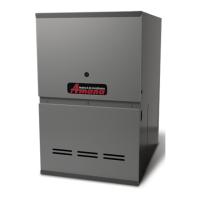27
1. Turn OFF gas to furnace at the manual gas shutoff valve
external to the furnace.
2. Turn off all electrical power to the system.
3. Outlet pressure tap connections:
White-Rodgers 36J54 valve: Back outlet pressure
test screw (inlet/outlet pressure tap) out one turn
(counterclockwise, not more than one turn).
4. Attach a hose and manometer to outlet pressure tap .
5. Turn ON the gas supply.
NOTE: Follow this procedure to test the gas valve pressure
at 100% ring rate.
NOTE: the Cool Cloud phone application be used to assist with
all functional tests. See the quick start guide section for details.
The furnace should be inspected by a qualied installer, or
service agency at least once per year. This check should be
performed at the beginning of the heating season. This will
ensure that all furnace components are in proper working or-
der and that the heating system functions appropriately. Pay
particular attention to the following items. Repair or service
as necessary.
Measuring Inlet Gas Pressure (Alt. Method)
Figure 33
NOTE: When converting from natural gas to L.P. consult
your distributor for proper conversion kit.
Range Nominal
Low Stage 1.6 - 2.2" w.c. 1.9" w.c.
High Stage 3.2 - 3.8" w.c. 3.5" w.c.
Low Stage 5.7 - 6.3" w.c. 6.0" w.c.
High Stage 9.7 - 10.3" w.c. 10.0" w.c.
gAS input rAte meASurement (nAturAl gAS only)
The actual gas input rate to the furnace must never be greater
than that specied on the unit rating plate. To measure natural
gas input using the gas meter, use the following procedure.
1. Turn OFF the gas supply to all other gas-burning appliances
except the furnace.
2. While the furnace is operating at high re rate, time and
record one complete revolution of the gas meter dial,
measuring the smallest quantity, usually the dial that
indicates 1/2 cu. ft. per revolution. You will use this
number to calculate the quantity of gas in cubic ft. if the
furnace would consume if it ran steadily for one hour
(3600 seconds).
3. If the 1/2 cu. ft. dial was used, multiply your number by
two. EXAMPLE: If it takes23 seconds to complete one
revolution of the 1/2 ft. dial (23 x 2 = 46).
This tells us that at this rate, it would take 46 seconds to
consume one cu. ft. of gas. 3600 / 46 = 78.
This tells us that in one hour, the furnace would consume 78
cu. ft. of gas. The typical value range for 1 cu. ft. of natural
gas is around 1000 BTU. Check with your gas utility, if possi-
ble. In this example, the furnace is consuming 78,000 BTUH.
NOTE: The nal manifold pressure cannot vary by more than
± 0.3” w.c. for Natural and + 0.5” for LP from the specied
setting. Consult your local gas supplier if additional input rate
adjustment is required.
4. Turn ON gas to and relight all other appliances
turned off in step 1. Be certain that all appliances
are functioning properly and that all pilot burners are
operating.
temperAture riSe
Temperature rise must be within the range specied on the unit
rating plate. An incorrect temperature rise may result in condensing
in or overheating of the heat exchanger. An airow and tempera-
ture rise table is provided in the Specication Sheet applicable to
your model. Determine and adjust temperature rise as follows:
1. Operate furnace with burners ring for approximately ten
minutes. Ensure all registers are open and all duct dampers
are in their nal (fully or partially open) position.
2. Place thermometers in the return and supply ducts as close
to the furnace as possible. Thermometers must not be
inuenced by radiant heat by being able to “see” the heat
exchanger.

